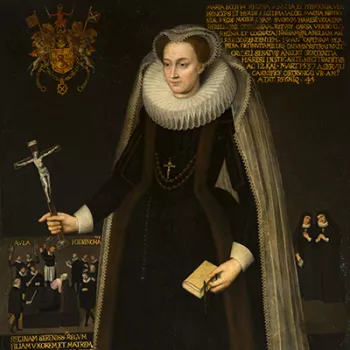The Palace of Holyroodhouse today
The Palace of Holyroodhouse is the official residence of the Monarchy in Scotland. As well as being used as a royal palace, it is open to visitors all year round.
Holyrood Week
Each year the Monarch spends a week visiting a variety of regions in Scotland, meeting Scots from all walks of life and hosting them at the Palace in recognition of their good work. Known in Scotland as ‘Royal Week’ and to others as ‘Holyrood Week’, these visits celebrate Scottish culture, achievement, and community.
The Monarch’s stay in Edinburgh usually takes place from the end of June to the beginning of July. The Scottish variant of the Royal Standard of the United Kingdom is flown, and the Royal Company of Archers forms His Majesty's ceremonial bodyguard.
The week usually includes the Ceremony of the Keys, an Investiture, a Garden Party and several regional Scottish engagements. King Charles III and Queen Camilla’s first Royal Week took place in July 2023.
Ceremony of the Keys
The King is welcomed into the city of Edinburgh by the Lord Provost, who offers the keys of the city. The Palace forecourt is transformed into a colourful parade ground, where guests stand to watch the enactment of an ancient ceremony.
On arrival in the forecourt, The King is presented with a red-velvet cushion, on which rests the great key of the city. It is handed to The King by the Lord Provost, who welcomes His Majesty formally and pledges the city’s loyalty. His Majesty then hands back the key for safekeeping.
Garden Party and Investiture
King George V and Queen Mary held the first garden party in the grounds of Holyroodhouse and the tradition has been maintained to the present day. Queen Elizabeth II held over 50 garden parties at the Palace during her reign.
The King and Queen with the Princess Royal welcomed 8,000 Scots to the gardens of Holyroodhouse in 2023. Guests at the Garden Party represent all walks of life and include those who have made a positive impact in their community. His Majesty also held an Investiture in the Great Gallery for Scottish residents whose achievements have been recognised.
The National Service of Thanksgiving and Dedication
The Honours of Scotland, also known as the Scottish Crown Jewels, were presented to King Charles III in a ceremony at St Giles’ Cathedral, Edinburgh, on 5 July 2023. The Jewels were returned to Edinburgh Castle after the ceremony.
Comprising the crown, sword and sceptre, the oldest Crown Jewels in Britain were rediscovered in Edinburgh Castle in 1818 by Sir Walter Scott. The crown was made for James V, but it was his daughter Mary, Queen of Scots, who was the first to be crowned using the crown and sceptre together in 1543.
The service was followed by a 21-gun salute from Edinburgh Castle and a flypast by the RAF's Red Arrows.
The Duke of Rothesay
The Prince of Wales, upon becoming heir to the throne, took on the traditional titles of the Scottish peerage, of Duke of Rothesay; Earl of Carrick; Baron Renfrew; Lord of the Isles; and Prince and Great Steward of Scotland. While in Scotland he is known as The Duke of Rothesay.
Recent changes at the Palace
The Palace of Holyroodhouse is everchanging and in 2020 a programme of works was completed which included a new ticketing and welcome area, and the visitor facilities and step-free access were improved. The display of the Royal Collection at the Palace was also refreshed, with a greater focus on telling the stories of Holyrood's former residents. A Learning Centre for teaching, learning activities and lectures was created in the Abbey Strand buildings, the oldest part of which dates from around 1490. Behind the Learning Centre, a new public garden was created, inspired by the earliest recorded gardens at the Palace.
Discoveries at the Palace
As part of the programme of works at the Palace, more than 40 trenches were dug for an archaeological survey.
A medieval shoe, a 300-year-old smoking pipe, a fragment of a 12th-century jug and the skeleton of a horse were just some of the discoveries made. Most of the finds were uncovered in or around the Abbey Strand buildings in the Canongate, among the earliest surviving structures in Edinburgh. These provide a glimpse into the lives of residents over the centuries.
Excavations in the Abbey Strand buildings by the Edinburgh-based firm Kirkdale Archaeology uncovered the earliest evidence of settlement on the site. Timber posts dating from the 12th century may mark the location of a terrace that led to the then low-lying island on which Holyrood Abbey was built in 1128 or could have formed part of a structure used by the workmen who built the Abbey. Work in the Palace gardens uncovered evidence of their development since the 12th century.















